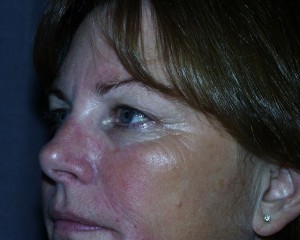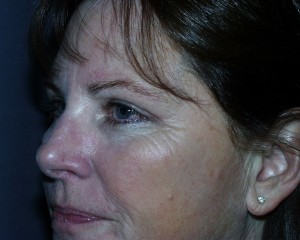The upper eyelids are an important feature of the face. They protect, moisturize and are an important aesthetic feature for the eye. They are also frequently the first place the signs of aging appear. Aging of the upper eyelids manifests mainly in two areas: excess skin and excess fat.
The most important is excess skin, and this can be compounded by excess fat. An aging eyelid can give a tired, sleepy, heavy appearance. The lids may also feel heavy, and if you have upper eyelids that feel heavy, it can make you feel tired. As the skin excess increases, it can interfere with vision.
An upper blepharoplasty (upper eyelid surgery) removes excess skin and fat from the eyelid. Care must be taken to remove the excess; however, sufficient skin must remain so that the eyelid can close fully. Removing too much upper eyelid skin can give a startled appearance, or lead to chronically dry and irritated eyes. If you have dry eyes, and are considering eyelid surgery, be certain to inform your plastic surgeon so that the proper care can be given. It is very important to find a qualified plastic surgeon, with experience in this area.
Upper Eyelids
In extreme cases, excess upper eyelid skin can interfere with your vision. Excess skin on the outer half of the eyelid obstructs peripheral vision, while excess skin centrally obstructs upward gaze. Occasionally, when vision is blocked, insurance will cover the cost of the procedure. You will need to check with your insurance to see if upper blepharoplasty is covered, as coverage varies from company to company.
While the primary goal is to remove the excess skin, excess fat can also be removed. Normally, excess fat of the upper eyelid is found medially (closest to the nose). Reducing the excess is an artistic endeavor. Just enough to smooth, but not enough to hollow. Removing too much will accelerate aging, rather than slowing or reversing it effects.
If you are interested in eyelid surgery, you may also be interested in these blog entries (some are coming soon):
- Eyelid Rejuvenation (Blepharoplasty)
- Lower Eyelid Rejuvenation (Lower Blepharoplasty)
- Internal Approach to the Lower Eyelids (Transconjunctival Blepharoplasty)
- Asian Eyelid Rejuvenation (Asian Blepharoplasty)
Additional information about eyelid surgery is also available on www.DrMele.com
Previous Post Next Post
